As an Amazon Associate I earn from qualifying purchases.
This simple recipe teaches you how to make Arepas at home with just 2 ingredients. Crispy outside and fluffy inside, homemade arepas taste delicious on their own, or stuffed with black beans, avocado, pull pork and much more.
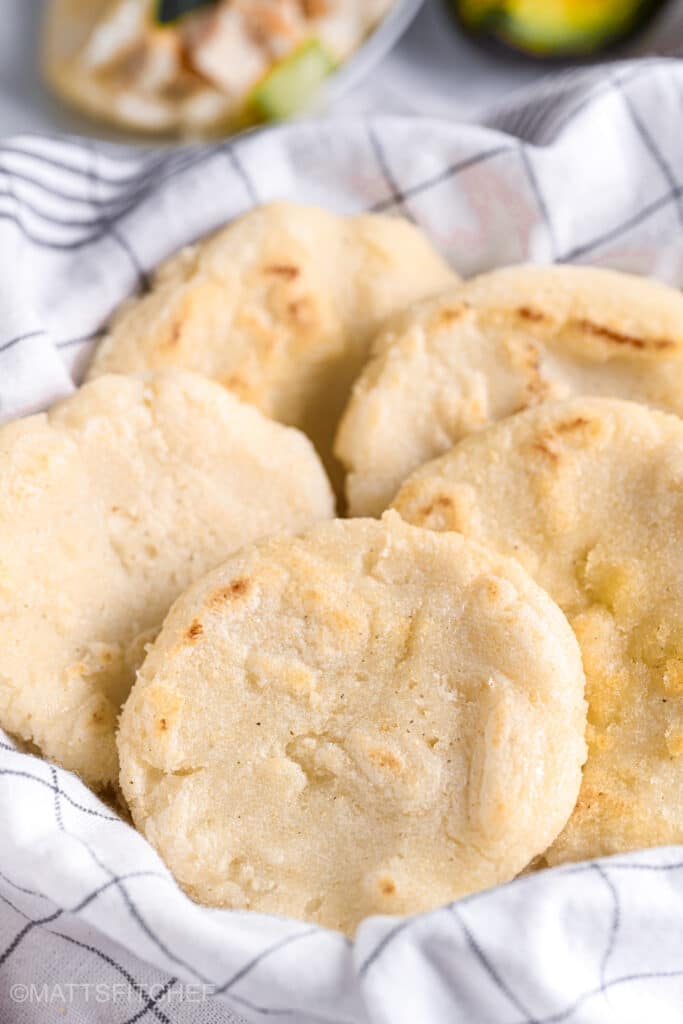
Today I’m excited to share my simple Arepas Recipe. Flavorful and so versatile, these corn patties will become part of your weekly rotation. From breakfast to lunch and snack, it’s always a good time to eat arepa de maiz! Healthy, gluten-free, dairy-free and vegan.
I first tried arepas last year, at the age of 23. That Sunday we were enjoy our walk when my girlfriend got hungry. She’d been mentioning sancocho, tamales and empanadas for weeks, because she was feeling a little nostalgic. By the way, she’s from Latin America and we live in Europe.
On our way home, there’s a food court where they specialize on Latin cuisine. Listening to her cravings, we entered to get some good food. Welcome to La Arepa, one of the best things I’ve ever tried. We asked for a meaty filling with pulled pork, black beans, creamy avocado and cotija cheese. Lunch that day was oh so delicious – the beginning of a new obsession.
Table of Contents
What are Arepas?
Arepas are South American corn cakes made with precooked cornmeal, water and salt. Originally they were cooked in a pan called “budare“, but they can also be baked or grilled. These corn cakes are a staple of the Latin cuisine, and people like eating them alone, or stuffed with meats, cheeses and beans. These corn pockets are perfect for breakfast, lunch and dinner, or as a snack.
La arepa de maiz was first made by the indigenous peoples in pre-Columbian Southern America, in the territories of what is nowadays Venezuela and Colombia. Originally, the name referred to “the everyday bread” (“El pan de cada día”). Corn was cheap, abundant, filling and nutritious, so areas were a staple in people’s diet.
Arepas are a national food from Venezuela and Colombia, but they can also be found in other Latin countries like Bolivia and Panama. The Mexican version of arepa are Gorditas. In El Salvador and Honduras, they have Pupusas instead.
There is a slight difference between Colombian arepas and Venezuelan arepas. In Colombia, they are usually thinner. People often prepare them cheesy, or also sweet sometimes. The Venezuelan arepas recipe instead makes them thicker and smaller in diameter.
What is an Arepa made of?
The authentic arepa recipe requires just 3 basic ingredients: masarepa, warm water and salt. Plus oil or butter for cooking.
But to be precise, you really need just 2 ingredients. Masarepa and lukewarm water (about 90°F/ 30°C). The salt is optional if you want a more savory taste. Here at home, we usually prepare them without salt because the fillings are already quite savory themself.
Let’s talk about masarepa
Since it is the main ingredient, it is also what determines the outcome. The classic arepas recipe requires a special flour called “masarepa”. You can also find it under the names of “harina precocida”, “areparina”, or “harina pan”.
In English, masarepa is pre-cooked corn meal. Once again, to make arepas you will need pre-cooked corn meal, either from yellow corn or white corn. Regular cornmeal and polenta will not work.
The two most popular brands selling this flour are Pan and Goya, I used Pan precooked white cornmeal. If you have a grocery store that specializes on Latin foods in the neighborhood, you will easily find it there. If you can’t find it, I recommend purchasing it from Amazon. I get masarepa from Amazon.
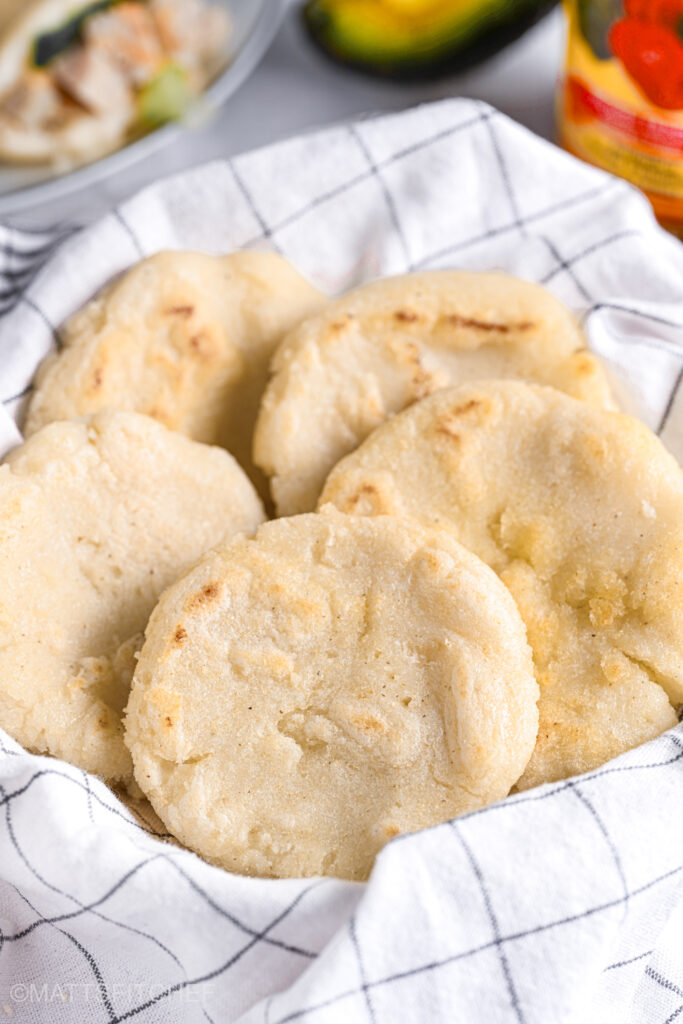
How to make arepas
For quick and easy corn cakes I usually cook mine in a cast-iron skillet. But arepas can also be grilled, deep-fried, or baked in the oven. Some people also pan fry them first, and then they finish them in the oven. For the precise directions, refers to the recipe card down below.
Step 1 – Make the arepa dough. In a large mixing bowl, add masarepa (pre-cooked white corn meal) and salt. Gradually pour in the lukewarm water, mixing with your hands or a spoon until the dough is smooth and free of lumps. If the dough is too dry, add more water until it reaches a smooth texture.
The arepa dough should be moldable, smooth and moist – something like playdough. In case it is too thick and dry, add 1 to 2 tablespoons of warm water more and knead until you reach the desired texture. If it is too wet and sticky instead, fix the dough with some more masarepa.
Step 2 – Let the dough rest. Cover the bowl with a clean kitchen towel and let it rest for about 10 minutes. You can leave it on the counter, or you can place it in the fridge.
Step 3 – Shape the arepas. Slightly wet your hands so that the dough does not stick, then divide it into small balls. Flatten each ball into a patty about 1/2 inch thick and 3-4 inches in diameter. I got six, but you may end up with fewer or more arepas depending on how big you shape them.
If you notice that the arepa is dry or it cracks on the side, brush the surface with little water to moisten it.
Step 4 – Cook the corn cakes. Heat a large cast-iron skillet or pan greased with oil or butter. When hot, add the arepas and cook over low-medium heat for 5 to 7 minutes on both sides. Do not overcrowd the pan, it is better to cook them in multiple batches. Arepas are ready when golden brown and crispy on the outside, but still tender inside.
After pan frying, you can finish off the corn patties in the oven. Arrange arepas over a parchment paper covered baking sheet and bake in hot oven at 350°F (180°C) for about 5 to 10 minutes. They will get even crispier.
Storage directions
Arepas de maiz taste delicious freshly made, but they can also be prepared ahead for later. To store arepas, allow them to cool completely after cooking. Once they are cool, transfer into an airtight container and refrigerate for up to 4 days. Reheat for a couple of minutes in a preheated skillet or in the oven before serving.
To freeze arepas, let them cool first. Once they have cooled, transfer the patties to zipper bags or to an airtight container and freeze for up to 1 month. Before serving, let frozen arepas thaw in the fridge and then reheat in a hot skillet or in the oven.
Recipe tips
- In Venezuela and Colombia, people make arepa masa (dough) using their hands, and you should too. Kneading by hand has two benefits: it creates a smoother “masa” and lets you feel the texture. This way, you can easily tell if the dough needs more water or flour.
- Customize the basic arepa recipe with your favorite spices and seasonings, or mix in the dough some shredded cheese like cotija to make delicious arepas con queso.
- After mixing, cover the bowl and let the arepa dough rest for about 10 minutes. Many people overlook the importance of this step, but it is essential because it improves the texture.
- Pan-fry arepas over low to medium heat, with a lid on for even cooking. It’s better to cook them longer at a lower temperature so they come out perfectly crispy on the outside but still fluffy and tender inside, without burning.
- As an alternative to pan frying, you can grill or bake them at 350°F (180°C) for about 10 minutes on both sides. Or cook arepas in the air fryer at 375°F (160°C) for about 15 minutes, flipping halfway through.
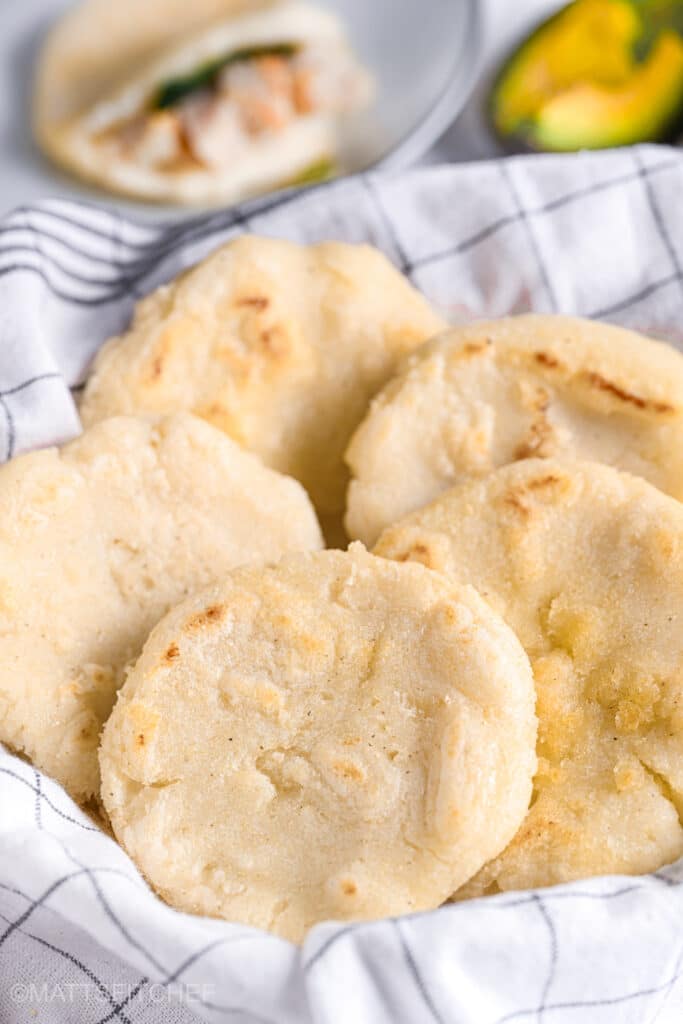
What to serve arepas with?
Serve the corn meal pockets warm, on their own or with your favorite fillings as a sandwich. Some serving ideas for arepas are stewed black beans, avocado or guacamole, pulled pork, carnitas, chicken, cheese and plantain (we love patacones). Here are some more suggestions.
- Stuff with baked beans, pulled pork or chicken, guacamole and homemade salsa.
- Fill with shredded chicken salad, creamy avocado, fresh lettuce and tomatoes.
- With Mexican street corn salad or Mexican street corn dip on the side.
- Stuff with cheese, chicken, beans and salsa like a chicken quesadilla recipe.
- With sunny side up eggs, cheese and avocado for breakfast.

Arepas
Equipment
Ingredients
- 1 ¼ cup (150 g) masarepa, also known as "harina precocida", "harina pan", or pre-cooked white cornmeal
- 1 cup (240 ml) warm water
- ½ tsp salt, or to taste, optional (see notes*)
- olive oil or butter, for pan-frying arepas
Instructions
- In a large mixing bowl, add masarepa (pre-cooked white corn meal) and salt. Gradually pour in the lukewarm water, mixing with your hands or a spoon until the dough is smooth and free of lumps.If the dough is too dry, add more water until it reaches a smooth texture. If it is too sticky instead, add more masarepa.
- Cover the bowl with a clean kitchen towel and let it rest for about 10 minutes. You can leave it on the counter, or you can place it in the fridge.
- Slightly wet your hands so that the dough does not stick, then divide it into small balls. Flatten each ball into a patty about ½ inch thick and 3-4 inches in diameter. I got 6, but you may end up with fewer or more arepas depending on how big you shape them.
- Heat a large cast-iron skillet or a pan greased with oil or butter. When hot, add the arepas and cook over low-medium heat for 5 to 7 minutes on both sides. Do not overcrowd the pan, it is better to cook them in multiple batches.Arepas are ready when golden brown and crispy on the outside, but still tender inside.
- Slice homemade arepas and serve with avocado, cheese, pulled pork, blacked beans or your favorite fillings.
Notes
Ingredient notes
- Masarepa. To make arepas you need to use a specific flour called “masarepa”, “harina precocida”, “areparina”, or”harina pan”. In English speaking countries, it is usually sold as pre-cooked corn meal. You can find masarepa in Latin grocery stores, in large supermarkets, or on Amazon. I usually get masarepa from Amazon.
- A pinch of salt. Salt is not strictly needed to make arepas. However, it does add more taste and flavor. For delicious, savory arepas add half teaspoon of sea salt to the masarepa when making the dough.
How to store homemade arepas
- To store. Allow the arepas to cool completely after they are ready. Once they are cool, transfer into an airtight container and refrigerate for up to 4 days. Reheat for a couple of minutes in a hot skillet or in the oven before serving.
- To freeze. Let arepas cool, then transfer to zipper bags or to an airtight container and freeze for up to 1 month. Before serving, let frozen arepas thaw in the fridge and then reheat in a hot skillet or in the oven.
Nutritional values
- Nutritional values are provided for a single arepa, without considering oil or fillings.
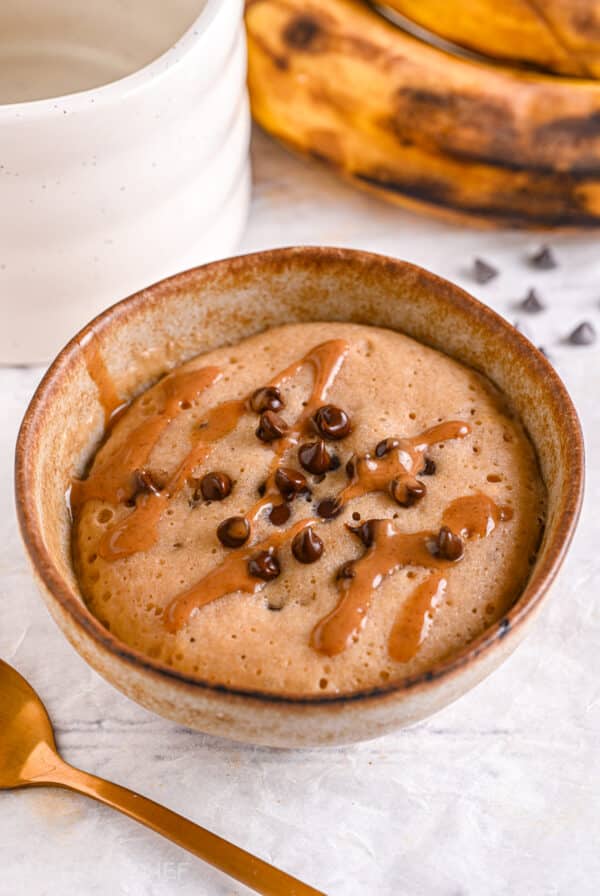

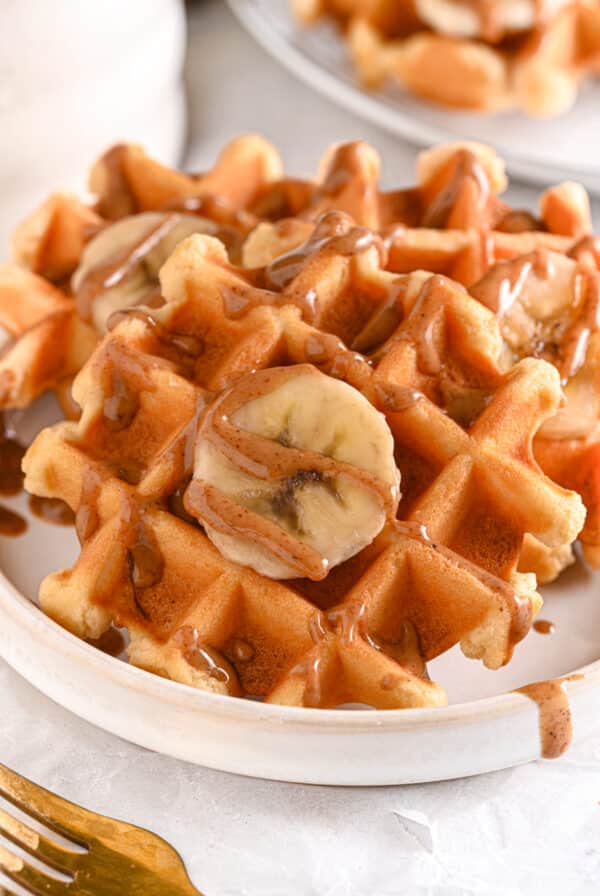
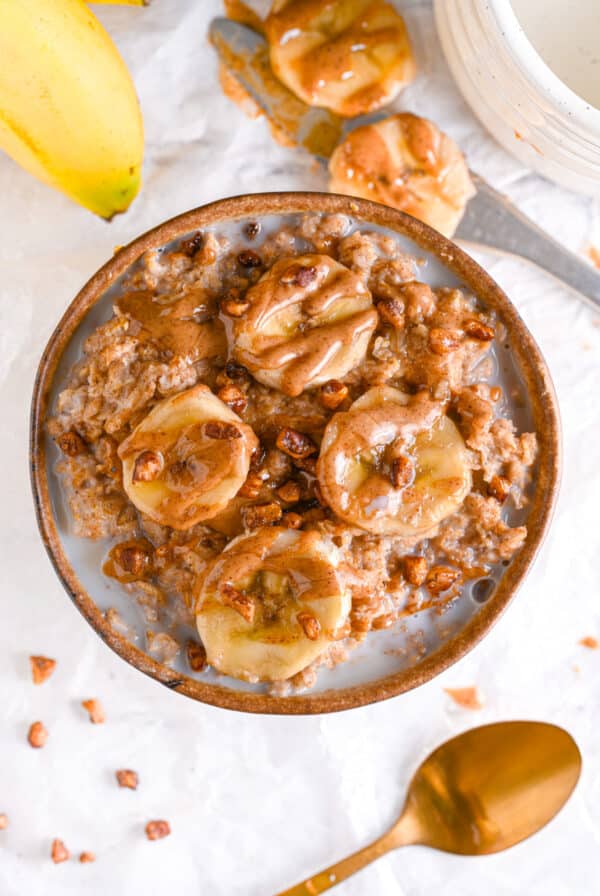
Will make your arepa with my grilled chicken, tomato, lettuce and cilantro sauce Matt. Thanks for your recipe.
Hey dear Constantino,
many many thanks for your kind feedback!! It truly makes me happy that you appreciate my arepa recipe 😉
Oh, I love your filling ideas! The cilantro definitely hits the spot, I also recommend some Pico de Gallo!
Have a great day,
Matteo
Your recipe of arepa looks fantastic and delicious!!! I like to eat arepa at any time of the day.
Hey dear Liza,
thanks a lot for your feedback!! I totally agree with you, nothing will ever beat the original cheese arepas de queso 😉 Missing Panama so much!!
I wish you a fantastic day,
Matteo